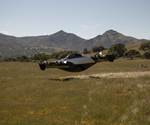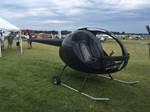Composites-intensive helicopter makes commercial debut
The newest model from Safari Helicopters includes an all-composite freestanding tail boom and other composite parts built by Carbon Fiber Composites Inc.

Source | RCBI
A composite-intensive helicopter, developed by a collaboration between Carbon Fiber Composites Inc. (Ona, W.Va., U.S.), Safari Helicopters (Marianna, Fla., U.S.) and the Robert C. Byrd Institute (RCBI) at Marshall University (Huntington, W.Va., U.S.), is now commercially available and has made its first sales.
“What makes the Safari helicopter different is it is composed almost entirely of composite materials and is one of the only helicopters on the market to utilize an entirely composite freestanding tail boom, which allows for simpler and less expensive repairs,” says Brian Alley, owner of Carbon Fiber Composites.
The Safari helicopter made its debut at the 2018 Experimental Aircraft Association’s AirVenture, the world’s largest annual convention for aviation enthusiasts that takes place in Oshkosh, Wisconsin. The company’s team returned to Oshkosh this year to demonstrate the aircraft’s capabilities by providing rides for convention participants and potential buyers. Carbon Fiber Composites is now manufacturing all of the composite components entirely in West Virginia to fulfill orders for the new aircraft.
“This new aircraft is an example of a company identifying a niche market and taking advantage of RCBI’s resources to grow its business,” says Charlotte Weber, RCBI’s director and CEO. “From our startup support, to design engineering prototypes to manufacturing assistance, RCBI has been helping to build and diversify West Virginia’s economy for 30 years by supporting businesses like Carbon Fiber.”
Related Content
-
Welding is not bonding
Discussion of the issues in our understanding of thermoplastic composite welded structures and certification of the latest materials and welding technologies for future airframes.
-
Plant tour: Spirit AeroSystems, Belfast, Northern Ireland, U.K.
Purpose-built facility employs resin transfer infusion (RTI) and assembly technology to manufacture today’s composite A220 wings, and prepares for future new programs and production ramp-ups.
-
Manufacturing the MFFD thermoplastic composite fuselage
Demonstrator’s upper, lower shells and assembly prove materials and new processes for lighter, cheaper and more sustainable high-rate future aircraft.

.jpg;width=70;height=70;mode=crop)













